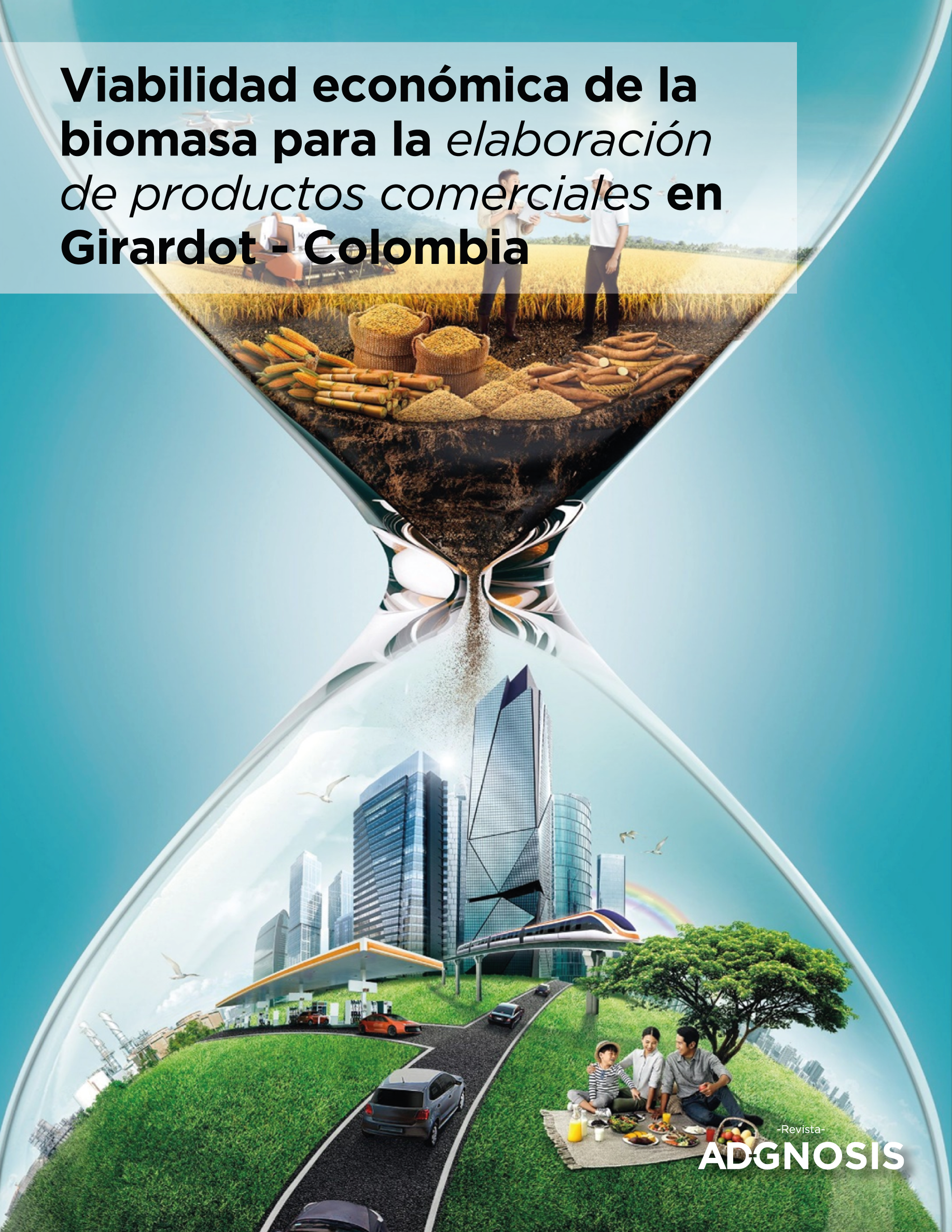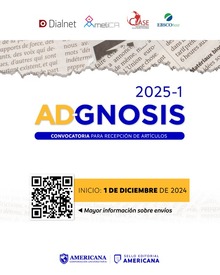Economic viability of biomass for the production of commercial products in Girardot - Colombia
DOI:
https://doi.org/10.21803/adgnosis.14.15.909Keywords:
Biomass, Microalgae, Repellent, Food security, FeasibilityAbstract
Introduction: This research identifies the economic,
financial and technical feasibility for the production
of microalgae from wastewater produced in the Barzalosa irrigation district in Alto Magdalena (Girardot
Cundinamarca - Colombia); algae that are used as fish
food and the production of repellent based on the seeds of 1330 Neem trees (Azadirachta Indica), a non-native species present in the municipality of Girardot, accepted by the local inhabitants who use it to attenuate the intensity of sunlight. Both resources, abundant in the region, present opportunities to develop sustainable
products that contribute to food security and pest control. Economic viability depends on the implementation
of sustainable cultivation practices and a constant
supply of raw materials.
Downloads
References
Ahmed, S. & Grainge, M. (1986). Potential of the neem tree (Azadirachta indica) for pest control and rural development. Economic Botany, 40, 201-209. https://doi.org/10.1007/BF02859144.
Aiba, S. (2005). Growth kinetics of photosynthetic microorganisms. In A. Fiechter (Ed.), Advances in Biochemical Engineering (pp. 85-156). Springer-Verlag Berlin Heidelberg GmbH.
Balasubramaniyan, B. & Jayaraman, J. (2012). Integrated dairy plant effluent treatment and production of biomass and lipids using micro algae- "Chlorella vulgaris". International Journal of Chemical Reactor Engineering, 10 (1). https://doi.org/10.1515/1542-6580.2658
Béchet, Q., Shilton, A. & Guieysse, B. (2013). Modeling the effects of light and temperature on algae growth: State of the art and critical assessment for productivity prediction during outdoor cultivation. Biotechnology Advances, 31(8), 1648-1663.
Blankenship, R. E. (2014). Molecular mechanisms of photosynthesis. WileyBlackwell Boursier, C., Bosco, D., Coulibaly, A. & Négre, M.
(2011). Are traditional neem extract preparations as efficient as a commercial formulation of azadirachtin A? Crop Protection, 30 (3), 318-322. https://doi.org/10.1016/J.CROPRO.2010.11.022
Chaudhary, S., Kanwar, R. K., Sehgal, A., Cahill, D. M., Barrow, C. J., Sehgal, R. & Kanwar, J. R. (2017). Progress on Azadirachta indica based biopesticides in replacing synthetic toxic pesticides. Frontiers in plant science, 8. 226969. https://doi.org/10.3389/fpls.2017.00610
Chmiel, H. (2011). Bioprozesstechnik. Spektrum Akademischer Verlag.
Deviram, G., Mathimani, T., Anto, S., Ahamed, T. S., Ananth, D. A. & Pugazhendhi, A. (2020). Applications of microalgal and cyanobacterial biomass on a way to safe, cleaner and a sustainable environment. Journal of Cleaner Production, 253, 119770.
García-Teruel, P. J., & Martínez-Solano, P. (2007). Effects of working capital management on SME profitability. International Journal of Managerial Finance, 3(2), 164–177. https://doi.org/10.1108/17439130710738718
Guevara Ibargüen, L. F. (2020). Análisis del potencial que presenta los residuos de poda del árbol neem (azadirachta indica) en el casco urbano de GIRARDOT (Cundinamarca) para la producción de biochar y su aplicación en el tratamiento de aguas. Editorial Universidad de Cundinamarca. https://www.ucundinamarca.edu.co/selloeditorial/
Isman, M. B., Koul, O., Arnason, J. T., Stewart, J. & Salloum, G. S. (1991). Developing a neem-based insecticide for Canada. The Memoirs of the Entomological Society of Canada, 123(S159), 39-46.
Jiménez, A. D., Cárdenas Carrillo, C., Ariza Tello, A., Echeverri, J. A., González, A. D., Gutiérrez, H. R., Matta, N., Rojas, T., R., Tiquidimas, D. R., Venegas, C. S., Vengoechea, C. & Keller, C. (2023). Indigenous ecological calendars and seasonal vector-borne diseases in the Colombian Amazon: an intercultural and interdisciplinary approach. Acta Amazonica, 53(2). https://doi.org/10.1590/1809-4392202200910.
Koul, O. & Wahab, S. (2004). Neem: today and in the new millennium. Kluwer Academic Publishers. https://landportal.org/organization/kluwer-academic-publishers
Kusmayadi, A., Leong, Y. K., Yen, H-W., Huang, C. Y. & Chang, J- S. (2020). Microalgae as sustainable food and feed sources for animals and humans–Biotechnological and environmental aspects. Chemosphere, 271(4), 129800.
Lugo-Arias, J., Burgos-Vergara, J., Lugo-Arias, E., Gould, A. & Ovallos-Gazabon, D. (2020). Evaluation of low-cost alternatives for water purification in the stilt house villages of Santa Marta's Ciénaga Grande. Heliyon, 6(1). https://doi.org/10.1016/j.heliyon.2019.e03062
Meyer, C.A. (2007). Working Capital and Corporate Value. Editorial Springer Verlag. Muhammad, I., Shin, J. H. & Kim, J. D. (2018). The promising future of microalgae: current status, challenges, and optimization of a sustainable and renewable industry for biofuels, feed, and other products. Microbial Cell Factories, 17(1), 36. https://doi.org/10.1186/s12934-018-0879-x
Schaeffer, M. S. (2002). Essentials of Accounts Payable (1st edition). Editorial Wiley.
Schmutterer, H. (1990). Properties and potential of natural pesticides from the neem tree, Azadirachta indica. Annual review of entomology, 35(1), 271-297. https://doi.org/10.1146/annurev.en.35.010190.001415
Singh, J. & Gu, S. (2010). Commercialization potential of microalgae for biofuels production. Renewable and Sustainable Energy Reviews, 14(9), 2596-2610. https://doi.org/10.1016/j.rser.2010.06.014
Smith, K.V. (1980). An Overview of Working Capital Management. (2nd ed.). Editorial McGraw-Hill.
Subramanian, S., Salleh, A. S., Bachmann, R. T. & Hossain, M. S. (2019). Simultaneous extraction and separation of oil and azadirachtin from seeds and leaves of Azadirachta indica using binary solvent extraction. Natural Product Sciences, 25(2), 150–156. https://doi.org/10.20307/nps.2019.25.2.150
Tesfaye, B., Tefera, T., Misikir, O. & Tsegaye G. (2020). Extraction and comparison of essential oil from neem seed by using soxhlet extraction and simple distillation methods. International Journal of Engineering Technologies and Management Research, 5(9), 74–81. https://doi.org/10.29121/ijetmr.v5.i9.2018.291
Viegas, C., Gouveia, L. & Gonçalves, M. (2021). Aquaculture wastewater treatment through microalgal. Biomass potential applications on animal feed, agriculture, and energy. Journal of environmental management, 286, 112187 https://doi.org/10.1016/j.jenvman.2021.112187
Wannang, N. N., Ajayi, V. F., Ior, L. D., Dapar, L. M. P., Okwori, V. A. & Ohemu, T. (2015). Mosquito Repellant Property of Azadirachta Indica Extract (Fruit Bark and Seed Kernel). Scientific Research Journal (SCIRJ), 3(6). https://www.scirj.org/papers-0615/scirj-P0615257.pdf
Weinraub, H. J. & Visscher, S. (1998). Industry Practice Relating to Aggressive Conservative Working Capital Policies. Journal of Financial and Strategic Decisions, 11(2), 11-18.
Yarnold, J., Karan, H., Oey, M. & Hankamer, B. (2019). Microalgal aquafeeds as Part of a Circular Bioeconomy. Trends in plant science, 24(10). https://doi.org/10.1016/j.tplants.2019.06.005
Hernandez Belaides, H. J. (2025). Beneficios de la energía solar en la conservación del medio ambiente mediante su uso en centros comerciales de Barranquilla. Sapiendus, 1(1), e-1. https://doi.org/10.70335/sapiendus.1.1.1
Jay Vanegas, W. ., Mugno Noriega, A. ., & Luis López, J. . (2021). Educación financiera, un enfoque al crecimiento y desarrollo social. Ad-Gnosis, 10(10), 43-55. https://doi.org/10.21803/adgnosis.10.10.468
Mosquera Castro, A. L. ., Leal Céspedes, J. C. ., & Montoya Monsalve, J. N. . (2021). El bienestar como práctica de alto rendimiento en la Organización. Una mirada desde el modelo de Ryff. Ad-Gnosis, 10(10), 83-101. https://doi.org/10.21803/adgnosis.10.10.471

Downloads
Published
Issue
Section
License
Copyright (c) 2025 AD-GNOSIS

This work is licensed under a Creative Commons Attribution-NonCommercial-NoDerivatives 4.0 International License.





